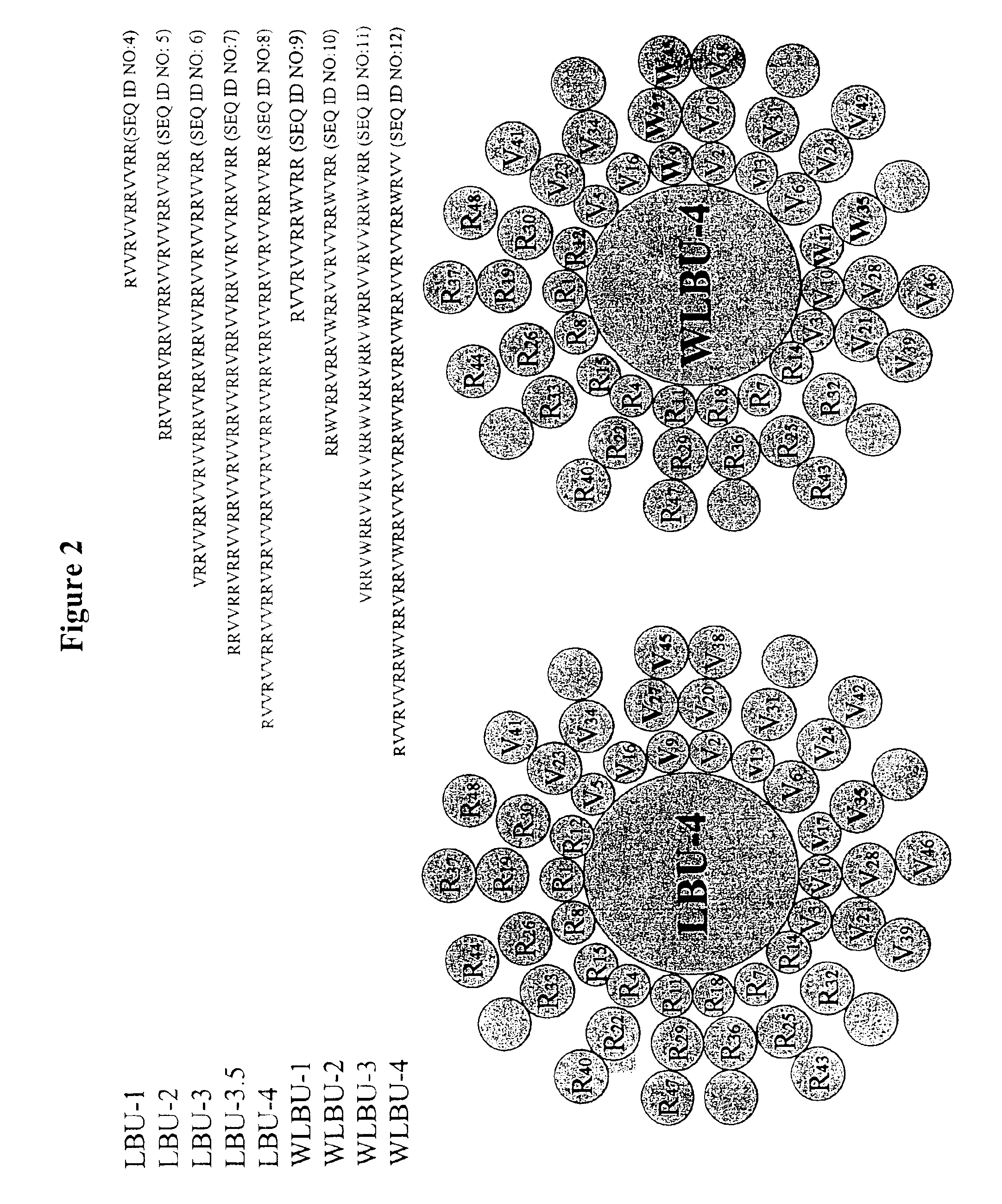Virus derived antimicrobial peptides
a technology of antimicrobial peptides and viruses, applied in the field of virus-derived antimicrobial peptides, can solve the problems of threatening the capacity to manage infectious diseases, emergence of bacterial strains that are no longer susceptible, and disrupting its structural integrity, so as to reduce the molar concentration required, broaden the spectrum of activity, and increase the effect of potency
- Summary
- Abstract
- Description
- Claims
- Application Information
AI Technical Summary
Benefits of technology
Problems solved by technology
Method used
Image
Examples
example 1
Design and Synthesis of eLLPS.
[0079]Design of eLLPs. Using the principles described above, peptide sequences were designed for synthesis based on altering the residues of the LLP1 parent sequence to create an Arg-rich hydrophilic face and a more idealized hydrophobic face of a predicted amphipathic α-helical structure. In one case, WLSA-5 (SEQ ID NO:3), Trp residues were included to increase potency and spectrum of activity (FIG. 1). For LBU-2 (SEQ ID NO:5) and LBU-3 (SEQ ID NO:6), an idealized amphipathic α-helical structure consisting of Arg residues and Val residues on the hydrophilic and hydrophobic faces, respectively, were designed and are described in FIG. 2.
[0080]Peptide Synthesis. Peptides were synthesized as described previously (see Miller, Jaynes and Montelaro, AIDS Research &Human Retroviruses 7:511-519 and Fontenot et al., Peptide Research 4:19-25) using either an Advanced Chemtech model 200 (Advanced Chemtech, Louisville, Ky.) or a Millipore 9050+ (Millipore, Bedford,...
example 2
Evaluation of Peptides Using in Vitro Bacterial Lysis Assays
[0082]Test Samples. The peptides used for this study are described and prepared as indicated above. The panel of bacterial isolates used for these experiments included both gram-positive and gram-negative clinical isolates. A given bacterial isolate was prepared as described below and exposed to a given eLLP as described below.
[0083]Bacterial lysis assay. Bacterial lysis assays were conducted in a manner similar to that described previously (Lehrer, R. I., M. E. Selsted, D. Szklarek, and F. J. 1983. Infect. Immun. 42: 10-4, 1983; Miller, M. A., R. F. Garry, J. M. Jaynes, and R. C. Montelaro, AIDS Res Hum Retroviruses 7: 511-519, 1991). Bacterial suspensions were cultured in Luria-Bertani Broth to mid-log growth phase and washed by two cycles of centrifugation and suspension in 10 mM phosphate buffer. The Abs600 of the suspension was adjusted with 10 mM phosphate buffer such that, upon dilution, 5-10×105 cfu / mL would be trea...
example 3
Cystic Fibrosis Cell Culture Model of Selective Toxicity
[0086]Preparation of bacterial cells. Burkholderia cepacia and P. aeruginosa isolates were obtained from clinical microbiology laboratories and assayed using the broth dilution method as described in Example 2.
[0087]Preparation of eukaryotic cells. Differentiated primary cell cultures of human bronchial epithelial (HBE) cells (CF and non-CF) on an air-liquid interface were prepared in antibiotic free media. See Zabner, J. et al., 1996, J Virol. 70:6994-7003. These filters were incubated with P. aeruginosa followed by washing to remove non-adherent bacteria. Individual filters were next exposed to peptide at increasing concentrations. In order to release viable bacteria, trypsin / EDTA was added and these preparations were plated on standard bacteriologic media to quantify bacterial survival. Similarly prepared cells were monitored for peptide toxicity by measuring transepithelial resistance. The advantage of this model is that it...
PUM
| Property | Measurement | Unit |
|---|---|---|
| Angle | aaaaa | aaaaa |
| Composition | aaaaa | aaaaa |
| Antimicrobial properties | aaaaa | aaaaa |
Abstract
Description
Claims
Application Information
 Login to View More
Login to View More - R&D
- Intellectual Property
- Life Sciences
- Materials
- Tech Scout
- Unparalleled Data Quality
- Higher Quality Content
- 60% Fewer Hallucinations
Browse by: Latest US Patents, China's latest patents, Technical Efficacy Thesaurus, Application Domain, Technology Topic, Popular Technical Reports.
© 2025 PatSnap. All rights reserved.Legal|Privacy policy|Modern Slavery Act Transparency Statement|Sitemap|About US| Contact US: help@patsnap.com



